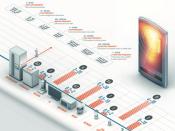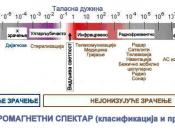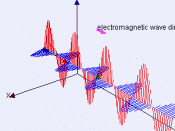Effects and Disease Related to CRT Monitors By: C.B. Rodgers, for The Paper Store - April 2001 VISIT www.paperwriters.com/aftersale.htm -- for more information on using this paper properly! Introduction As computers have become a common tool in virtually every enterprise, people have found that not all aspects of the safe, clean environment of working with computers is necessarily all that itâÃÂÃÂs cracked up to be. In fact, there are health concerns associated with computer use beyond the typical issues of carpal tunnel syndrome, backache, and the expanding-derrière factor associated with the sedentary behavior associated with computer use. Other concerns are linked to electromagnetic radiation.
Most often, electromagnetic radiation or EMR is associated with high-voltage powerlines, different household appliances, specialized computer use or a combination of factors. Obviously, people who spend a great amount of time engaged in computer work have a right to be concerned.
The student will be able to find a great deal of information relating to the fact that in the past decade, research efforts to identify the effect on the human body of electromagnetic radiation have increased.
Such radiation is found in various forms of technology such as cellular phones, radios, televisions, power lines, and computer monitors. Although it has been repeatedly presented as a concern, it has not been categorically proven that there is a definite link between electromagnetic fields and cancer. Nonetheless, there has always been a link between radiation and cancer and it is undeniable that computer monitors emit an electromagnetic field. And, aside from concerns about cancer, there are other health worries related to computer monitors. Those concerns range from emotional and physical stress, musculoskeletal problems, emotional problems, headaches, vision problems and more. Whether or not such problems can be proven, much less resolved, remains to be seen. Meanwhile, there are some very real concerns that should be considered.
Computer Monitor Emissions Electromagnetic radiation or electromagnetic fields (EMFs) are generated, in their simplest forms, through the electric power distribution system, including the transmission and distribution lines and the power delivered through the average wall socket. There are numerous devices using electric power exactly as it comes from the wall, more complex devices like video display terminals (VDTs) and computer monitors need to alter specific characteristics such as frequency, power level and waveform in order to accomplish the tasks necessary for creating an image on the screen. According to the NoRad Corporation (1998), the power inside a VDT is repeatedly divided and subdivided in order to create significantly higher frequencies.
When that takes place, it dramatically alters waveform and the original voltage. That means that there is a definite addition to the sinusoidal waveform, sawtooths, spikes, square waveforms and others that are produced, which generate corresponding electromagnetic waves, radiating outward from their sources. When they encounter each other, the process of modulation creates new and even more complex waves. The student working on this project will want to show the differences in radiation output in order to clarify different parts of his or her discussion.
Vision Problems According to Gallagher (1996), of all of the environmental factors affecting office personnel, eyestrain is the one thing most workers are concerned about. In fact, he cites a Louis Harris & Associates, Inc. survey that found that 44 percent of office workers surveyed rank eyestrain higher than both air quality (27 percent) and exposure to hazardous materials (12 percent) as their greatest health concern in the office environment. Gallagher also explains that the proliferation of personal computers on the desks of countless workers has led to serious difficulties because the lighting in the vast majority of offices was designed for traditional white-paper tasks, not computer tasks. âÃÂÃÂTypical white-paper tasks involve reading from a sheet of matte-finished white paper laid flat on a surface or by looking down at a sheet of paper in a typewriter. A computer screen could not be more different. Rather than being viewed in the horizontal or near-horizontal plane, the information is viewed in the vertical or near-vertical plane. Instead of having a matte finish, the task surface - the computer screen - is made of glass, which usually is highly reflectiveâÃÂà(pp. 22).
The screen glare that results from the incompatibility between computer tasks and lighting designed for white-paper tasks reduces the contrast between the words or graphics on the screen and the background. The lower the contrast is, the more difficult it is to see what is on the screen. Over time, the tiny muscles that make these adjustments become overworked, leading to the headaches and fatigue associated with eyestrain. According to the Berkeley Wellness Letter (11/99), people who use computers for long periods of time can develop computer vision syndrome, which is characterized by eyestrain, headache and pain. It can be prevented by making sure that the work area and equipment is set up properly to reduce the development of physical problems.
Cancer and Electromagnetic Radiation Electromagnetic radiation -- radio waves from radio and TV towers, microwaves from cell phones, cell sites, mobile phones, cordless phones, and microwave ovens (the last being a minor problem compared with the others). The background radiation has been rising significantly by factors of thousands in the general population since the Second World War. Cancer is partly genetic, but largely environmental. Our food, the toxins in the environment like air pollutants, benzine, toxins in food like saccharine, are shown to be potential carcinogens, all those PCVs and other fairly toxic chemicals, can damage cells, but evidence is very strong that electromagnetic radiation damages cells in a way that is potentially cancer causing. The student looking at incidence of cancer as related to computer use will want to pay special attention to whether or not an individualâÃÂÃÂs cancer may be the result of a secondary factor along with computer use.
Reproductive Problems Potential reproductive hazards related to exposure to computer monitors received a great deal of publicity during the 1980s when several "clusters" of birth defects or miscarriages were noted among computer users. As a result, epidemiologists launched a number of investigations into the reproductive consequences of work with computer monitors. Among the first seven studies, only one, conducted by Goldhaber, Polen, and Hiatt (1988) did show a moderately strong association between computer monitor use and adverse reproductive outcomes. A subsequent study by Windham, Fenster, (1990) of the same population convincingly demonstrated that the findings of the only unequivocally positive study were actually the results of various study design problems such as telephone interviewer bias. The student working on this report will want to consider other instances of studies in which there may have been problems with the actual study that altered the outcomes.
Even though the early studies regarding reproductive problems for people using computer monitor operators mostly failed to show any problems, there was still concern that such failure may have been related to study design in more than one instance. Furthermore, all of the studies used time spent at a computer monitor as the primary measure which may not have represented an adequate estimate of total exposure, so the question remained unanswered. Schnorr, Grajewski, et al (1991) conducted a study for the National Institute of Occupational Safety and Health that included precise measurements of operators' electromagnetic field exposure among 2430 married women ages 18-33. Use of computer monitors was not identified as a risk factor.
Conclusion There are a number of health problems that can be associated with extensive computer use, however, the actual electromagnetic radiation emitted from the CRT monitors should be of relatively minimal concern. For example, the incorrect positioning of the monitor can certainly result in eye strain, backache, fatigue, and other musculoskeletal problems. Rather obviously, radiation, in all of its forms, needs to be viewed as a meaningful health concern. However, the levels of radiation emitted from a computer screen actually produce less of a magnetic field than photocopiers or many, if not most, household appliances!





